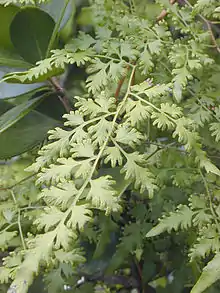Lygodium
Lygodium (climbing fern) is a genus of about 40 species of ferns, native to tropical regions across the world, with a few temperate species in eastern Asia and eastern North America. It is the sole genus in the family Lygodiaceae in the Pteridophyte Phylogeny Group classification of 2016 (PPG I).[1] Alternatively, the genus may be placed as the only genus in the subfamily Lygodioideae of a more broadly defined family Schizaeaceae,[2] the family placement used in Plants of the World Online as of November 2019.[3]
| Lygodium | |
|---|---|
 | |
| Lygodium japonicum | |
| Scientific classification | |
| Kingdom: | Plantae |
| Clade: | Tracheophytes |
| Class: | Polypodiopsida |
| Order: | Schizaeales |
| Family: | Lygodiaceae C.Presl |
| Genus: | Lygodium Sw. |
| Species | |
|
See text | |
| Synonyms[1] | |
|
(family)
| |
Description
Lygodium are unusual in that the rachis, or midrib, of the frond is thin, flexible, and long, the frond unrolling with indeterminate growth and the rachis twining around supports, so that each frond forms a distinct vine. The fronds may be from 3–12 m (9.8–39.4 ft) long, depending on the species.
Uses
Lygodium species, known as nito, are used as a source of fibers in the Philippines. The fibers are used as material for weaving, most notably of traditional salakot headgear.[4][5]
As invasive species
Some Lygodium species are now considered very problematic invasive weeds in the southeastern United States. Populations of Lygodium have increased more than 12-fold over the past decade, as noted by Florida's Institute of Food and Agricultural Sciences.[6]
Japanese climbing fern (Lygodium japonicum) was added to the Florida Noxious Weed List in 1999. It is also a major problem in pine plantations, causing contamination and harvesting problems for the pine straw industry. Old World climbing fern (Lygodium microphyllum) infests cypress swamps and other hydric sites, forming a monoculture. This massive infestation displaces all native flora and fauna, completely changing the ecosystem of the area.[7]
Plants in this genus have basal chromosome counts of n=28, 29, 30.
Selected species
- Lygodium articulatum – New Zealand (North Island).[8]
- Lygodium circinatum – Tropical Asia and Australasia.
- Lygodium conforme – China.
- Lygodium cubense – Cuba, Hispaniola.
- Lygodium digitatum – China.
- Lygodium flexuosum – Southern China south to northern Australasia, Kerala(South India).
- Lygodium japonicum – Japanese climbing fern. Eastern Asia south to northern Australia.
- Lygodium microphyllum (Cav.) R. Br. – Old World climbing fern. Africa, south Asia and Australia.
- Lygodium microstachyum – China.
- Lygodium palmatum (Bernh.) Swartz – American climbing fern. Eastern United States (rare, confined to acid soils).
- Lygodium polystachyum – China.
- Lygodium reticulatum – Australia, Polynesia.
- Lygodium salicifolium – Southern China south to northern Australasia.
- Lygodium subareolatum – China.
- Lygodium trifurcatum – Tropical southeast Asia south to northern Australasia.
- Lygodium volubile – Northern South America, Central America, Caribbean.
- Lygodium versteeghii – Tropical southeast Asia south to northern Australasia.
- Lygodium yunnanense – Southern China.
References
- PPG I (2016). "A community-derived classification for extant lycophytes and ferns". Journal of Systematics and Evolution. 54 (6): 563–603. doi:10.1111/jse.12229.
- Christenhusz, Maarten J.M. & Chase, Mark W. (2014). "Trends and concepts in fern classification". Annals of Botany. 113 (9): 571–594. doi:10.1093/aob/mct299. PMC 3936591. PMID 24532607.
- "Lygodium Sw". Plants of the World Online. Royal Botanic Gardens, Kew. Retrieved 2019-11-23.
- Salakot and Other Headgear (PDF). ICHCAP, UNESCO.
- "Lygodium (PROSEA)". Pl@ntUse. Retrieved 3 March 2020.
- "SS-AGR-21/AG122: Natural Area Weeds: Old World Climbing Fern (Lygodium microphyllum)". Edis.ifas.ufl.edu. Retrieved 2014-07-15.
- "Japanese climbing fern—Lygodium japonicum | Center for Aquatic and Invasive Plants". Plants.ifas.ufl.edu. Retrieved 2014-07-15.
- "Flora of New Zealand | General Profile | Lygodium articulatum". Nzflora.info. Retrieved 2014-07-15.
External links
| Wikimedia Commons has media related to Lygodium. |
- Flora of North America: Lygodium
- "Lygodium Sw". Australian Plant Name Index (APNI), IBIS database. Centre for Plant Biodiversity Research, Australian Government.
- C.Michael Hogan. 2010. Fern. Encyclopedia of Earth. eds. Saikat Basu and C.Cleveland. National Council for Science and the Environment. Washington DC.
- Flora of China: Lygodium species list